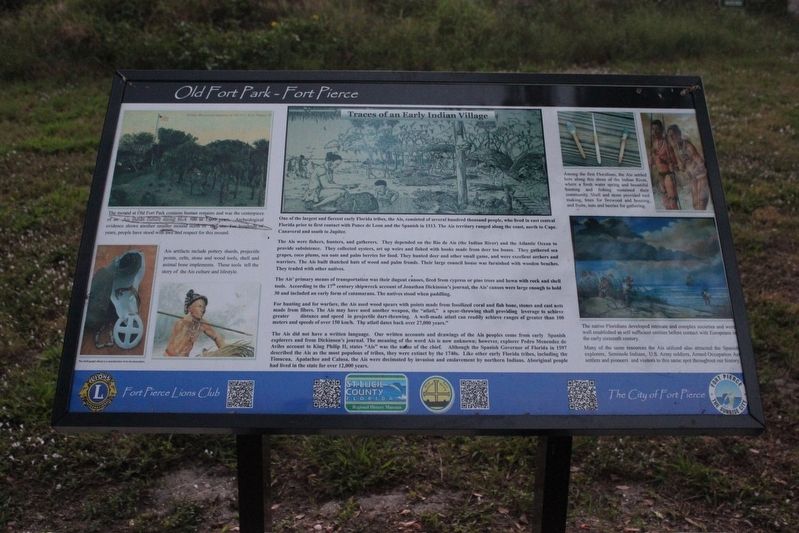Fort Pierce in St. Lucie County, Florida — The American South (South Atlantic)
Traces of an Early Indian Village
Old Fort Park - Fort Pierce
One of the largest and fiercest early Florida tribes, the Ais, consisted of several hundred thousand people, who lived in east central Florida prior to first contact with Ponce de Leon and the Spanish in 1513. The Ais territory ranged along the coast, north to Cape Canaveral and south to Jupiter.
The Ais were fishers, hunters, and gatherers. They depended on the Rio de Ais (the Indian River) and the Atlantic Ocean to provide subsistence. They collected oysters, set up weirs and fished with hooks made from deer toe bones. They gathered sea grapes, coco plums, sea oats and palm berries for food. They hunted deer and other small game, and were excellent archers and warriors. The Ais built thatched huts of wood and palm fronds, Their large council house was furnished with wooden benches. They traded with other natives.
The Ais' primary means of transportation was their dugout canoes, fired from cypress or pine trees and hewn with rock and shell tools. According to the 17th century shipwreck account of Jonathan Dickinson's journal, the Ais' canoes were large enough to hold 30 and included an early form of catamarans. The natives stood when paddling.
For hunting and for warfare, the Ais used wood spears with points made from fossilized coral and fish bone, stones and cast nets made from fibers. The Ais may have used another weapon, the "atlatl," a spear-throwing shaft providing leverage to achieve greater distance and speed in projectile dart-throwing. A well-made atlatl can readily achieve ranges of greater than 100 meters and speeds of over 150 km/h. The atlatl dates back over 27,000 years.
The Ais did not have a written language. Our written accounts and drawings of the Ais peoples come from early Spanish explorers and from Dickinson's journal. The meaning of the word Ais is now unknown; however, explorer Pedro Menendez de Aviles account to King Phillip II, states "Ais" was the name of the chief. Although the Spanish Governor of Florida in 1597 described the Ais as the most populous of tribes, they were extinct by the 1740s. Like other early Florida tribes, including the Timucua, Apalachee and Calusa, the Ais were decimated by invasion and enslavement by northern Indians. Aboriginal people had lived in the state for over 12,000 years.
Captions:
The mound at Old Fort Park contains human remains and was the centerpiece of an Ais Indian culture dating back 500 to 1,000 years. Archeological evidence shows another smaller mound north of this site. For hundreds of years, people have stood with awe and respect for this mound.
Ais artifacts include pottery shards, projectile points, celts, stone and wood tools, shell and animal bone implements.
These tools tell the story of the Ais culture and lifestyle.
Among the first Floridians, the Ais settled here along this shore of the Indian River, where a fresh water spring and bountiful hunting and fishing sustained their community. Shell and stone provided tool making, trees for firewood and housing, and fruits, nuts and berries for gathering.
The native Floridians developed intricate and complex societies and were well established as self sufficient entities before contact with Europeans in the early sixteenth century.
Many of the same resources the Ais utilized also attracted the Spanish explorers, Seminole Indians, U.S. Army soldiers, Armed Occupation Act settlers and pioneers and visitors to this same spot thought history.
Erected by Fort Pierce Lions Club, Saint Lucie Regional History Museum, Saint Lucie Historical Society, The City of Fort Pierce.
Topics. This historical marker is listed in these topic lists: Anthropology & Archaeology • Exploration • Native Americans • Settlements & Settlers. A significant historical year for this entry is 1513.
Location. 27° 26.22′ N, 80° 19.217′ W. Marker is in Fort Pierce, Florida, in St. Lucie County. Marker is on South Indian River Drive (County Road 707) 0.3 miles south of Florida Avenue, on the right when traveling south. Marker is located in Old Fort Park. Touch for map. Marker is at or near this postal address: 1001 S Indian River Dr, Fort Pierce FL 34950, United States of America. Touch for directions.
Other nearby markers. At least 8 other markers are within 2 miles of this marker, measured as the crow flies. Military Fort Pierce at Old Fort Park, Fort Pierce (within shouting distance of this marker); Old Fort Park (within shouting distance of this marker); Fort Pierce (within shouting distance of this marker); St. Lucie County (approx. 0.6 miles away); A.E. “Beanie” Backus Studio (approx. one mile away); A.E. “Bean” Backus (approx. one mile away); St. Lucie County Veterans Memorial (approx. 1.2 miles away); The United States Submarine Service Memorial (approx. 1.2 miles away). Touch for a list and map of all markers in Fort Pierce.
Credits. This page was last revised on August 3, 2019. It was originally submitted on May 20, 2018, by Tim Fillmon of Webster, Florida. This page has been viewed 418 times since then and 55 times this year. Photos: 1, 2. submitted on May 20, 2018, by Tim Fillmon of Webster, Florida. • Bernard Fisher was the editor who published this page.

